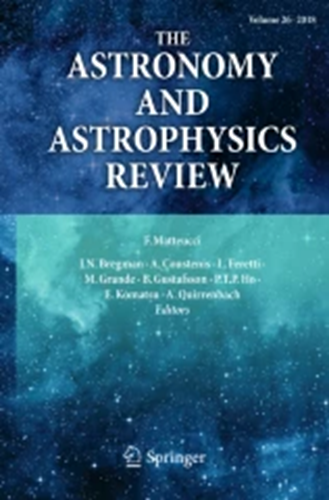Simulating the Galactic multi-messenger emissions with HERMES
IF 27.8
1区 物理与天体物理
Q1 ASTRONOMY & ASTROPHYSICS
引用次数: 11
Abstract
The study of non-thermal processes such as synchrotron emission, inverse Compton scattering, bremsstrahlung and pion production is crucial to understand the properties of the Galactic cosmic-ray population, to shed light on their origin and confinement mechanisms, and to assess the significance of exotic signals possibly associated to new physics. We present a public code called HERMES aimed at generating sky maps associated to a variety of multi-messenger and multi-wavelength radiative processes, spanning from the radio domain all the way up to high-energy gamma-ray and neutrino production. We describe the physical processes under consideration, the code concept and structure, and the user interface, with particular focus on the python-based interactive mode. We especially present the modular and flexible design that allows to easily further extend the numerical package according to the user's needs. In order to demonstrate the capabilities of the code, we describe in detail a comprehensive set of sky maps and spectra associated to all physical processes included in the code. We comment in particular on the radio, gamma-ray, and neutrino maps, and mention the possibility to study signals stemming from dark matter annihilation. HERMES can be successfully applied to constrain the properties of the Galactic cosmic-ray population, improve our understanding of the diffuse Galactic radio, gamma--ray, and neutrino emission, and search for signals associated to particle dark matter annihilation or decay.用HERMES模拟银河多信使发射
同步辐射、逆康普顿散射、轫致辐射和介子产生等非热过程的研究对于理解银河系宇宙射线种群的性质、阐明它们的起源和约束机制以及评估可能与新物理学相关的奇异信号的意义至关重要。我们提出了一个名为HERMES的公共代码,旨在生成与各种多信使和多波长辐射过程相关的天空图,从无线电领域一直到高能伽马射线和中微子的产生。我们描述了所考虑的物理过程、代码概念和结构以及用户界面,特别关注基于python的交互模式。我们特别提出了模块化和灵活的设计,可以根据用户的需要轻松地进一步扩展数字包。为了演示代码的功能,我们详细描述了与代码中包含的所有物理过程相关的一组全面的天空图和光谱。我们特别评论了无线电、伽马射线和中微子图,并提到了研究暗物质湮灭产生的信号的可能性。HERMES可以成功地应用于约束银河系宇宙射线种群的特性,提高我们对漫射星系射电、伽马射线和中微子发射的理解,并寻找与粒子暗物质湮灭或衰变相关的信号。
本文章由计算机程序翻译,如有差异,请以英文原文为准。
求助全文
约1分钟内获得全文
求助全文
来源期刊

The Astronomy and Astrophysics Review
地学天文-天文与天体物理
CiteScore
45.00
自引率
0.80%
发文量
7
期刊介绍:
The Astronomy and Astrophysics Review is a journal that covers all areas of astronomy and astrophysics. It includes subjects related to other fields such as laboratory or particle physics, cosmic ray physics, studies in the solar system, astrobiology, instrumentation, and computational and statistical methods with specific astronomical applications. The frequency of review articles depends on the level of activity in different areas. The journal focuses on publishing review articles that are scientifically rigorous and easily comprehensible. These articles serve as a valuable resource for scientists, students, researchers, and lecturers who want to explore new or unfamiliar fields. The journal is abstracted and indexed in various databases including the Astrophysics Data System (ADS), BFI List, CNKI, CNPIEC, Current Contents/Physical, Chemical and Earth Sciences, Dimensions, EBSCO Academic Search, EI Compendex, Japanese Science and Technology, and more.
 求助内容:
求助内容: 应助结果提醒方式:
应助结果提醒方式:


